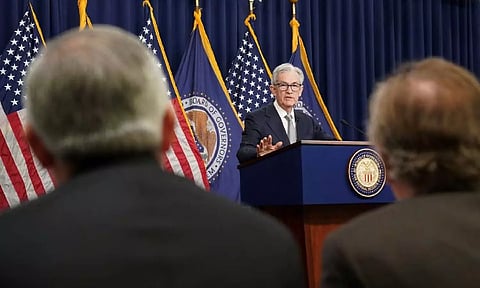

WASHINGTON: Slowing jobs growth and cooling wage pressures may give Federal Reserve policymakers renewed confidence the U.S. economy is adjusting from the shock of the coronavirus pandemic, allowing inflation to ease further without more interest rate rises.
That was the read from many analysts of the Labor Department report showing nonfarm payrolls increased by 150,000 last month, below the pre-pandemic trend for only the third time since December 2020, and hourly earnings rose 4.1% from a year earlier, the smallest increase since June 2021.
That was also the betting in financial markets. Bond yields fell, and traders of contracts tied to the Fed's policy rate now see only about a 10% chance of a rate hike by January, down from 30% before the employment report. Rate futures pricing now reflects a better-than-even chance of a Fed rate cut by May 2024, with several more cuts expected later next year.
U.S. policymakers themselves are not even thinking about rate cuts, Fed Chair Jerome Powell said this week after the central bank kept its benchmark overnight interest rate steady in the 5.25%-5.50% range.
They are waiting for more confirmation the economy is coming into better balance after pandemic disruptions to the supply of goods and labor helped push inflation to 40-year highs in 2022.
But Powell also signaled a further rate hike could yet be in the offing as he and his colleagues were not yet confident that monetary policy is restrictive enough to bring inflation down to the Fed's 2% target. He cited the rise in longer-term borrowing costs, including the rise in 30-year fixed-rate mortgages to nearly 8%, as potentially doing some of the Fed's work.
Friday's drop in the yield on the benchmark 10-year Treasury note to below 4.5% after the jobs report poses a problem that, if it continues, may actually bolster the case for another rate hike to ensure overall borrowing conditions do not loosen. So far, neither analysts nor Fed policymakers are framing the bond-yield drop itself as a spoiler.
"It's too soon to call," said Minneapolis Fed President Neel Kashkari, a skeptic of reading too much into financial market moves.
"We just need to keep watching the actual data to see, are we actually making enough progress to get inflation down to our 2% target," he said, adding that the latest data "gives us more comfort that the economy is moving back into balance."
A lot will hinge on inflation in the weeks leading up to the Fed's Dec. 12-13 policy meeting. Investors and analysts largely expect price pressures to continue easing and the Fed to remain on hold as a long-awaited hiring slowdown appears to take shape.
The average monthly payrolls gain over the last three months has slowed to 204,000, the latest report showed, after peaking in the summer of 2021 at 708,000. That is nearing the average monthly gain of 183,000 in the decade leading up to the pandemic.
The report, Richmond Fed President Thomas Barkin told CNBC, was "welcome to see" and backs up what he says businesses have been telling him.
"What I've been hearing is normalizing," Barkin said, adding that key will be what inflation reports show in coming months.
Inflation by the Fed's preferred measure has held around 3.4% for the last couple of months, down from 7.1% last summer but still above its 2% goal.
Atlanta Fed President Raphael Bostic also said he's closely watching inflation data, but told Bloomberg TV he feels that the fresh jobs data adds to his long-held view that for now rates are "sufficiently restrictive."
SOFT LANDING
After lifting the policy rate rapidly last year, Fed policymakers are seeking a stopping point that is high enough to bring inflation down but not so high that it does excessive damage to the labor market. Powell on Wednesday indicated the Fed is still steering toward what has been that historically elusive "soft landing" for the economy.
Overall, the latest jobs report was "tailor-made to match Powell's soft landing message from earlier this week," JPMorgan chief U.S. economist Michael Feroli said in a note to investors.
Despite Friday's bond yield drop and surge in stock prices that has loosened financial conditions, Feroli said, it will be the economic data that determines what the Fed will do, "and the data say we're done with rate hikes."
He and other analysts did note the report had hints of risk to that scenario, including a decline in the job-finding rate of those already unemployed, coupled with a second straight monthly uptick in unemployment.
"Continued upward momentum would be troubling, and hopefully this recent rise levels off as the labor market recovery continues," said Indeed.com's Nick Bunker.
Judging from the flow of workers into and out of jobs and job searches, said Inflation Insights' Omair Sharif, it appeared workers were having a tougher time landing employment, a reversal from the heady days of the "great resignation" when employees were skipping from job to job and some occupations were registering double digit wage gains.
Employment at bars and restaurants, a locus of high labor demand during the pandemic, dropped in October, he noted.
Still for now, most worries about the labor market appear to be focused on what might, or might not, be around the corner.
"We are transitioning to the next phase of recovery," said acting U.S. Labor Secretary Julie Su.